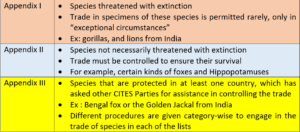Published on: March 3, 2023
WORLD WILDLIFE DAY 2023
WORLD WILDLIFE DAY 2023
NEWS – March 3 is known as World Wildlife Day (WWD)
WHY IS WORLD WILDLIFE DAY MARKED?
- In 2013, the United Nations General Assembly (UNGA) proclaimed March 3 as the UN World Wildlife Day to celebrate and raise awareness of protecting the world’s wild animals and plants. This was as the Convention on International Trade in Endangered Species of Wild Fauna and Flora (CITES) was signed in 1973 on this day
- March 3 marks the 50th anniversary of CITES’ establishment. CITES is considered a landmark agreement on conservation that focuses on ensuring the sustainability of endangered species
- Theme 2023 : Partnerships for Wildlife Conservation
WHAT IS THE CITES?
- International agreement between governments
- Aims to ensure that international trade in specimens of wild animals and plants does not threaten the survival of the species
- It was agreed upon with the recognition that “The trade in wild animals and plants crosses borders between countries, the effort to regulate it requires international cooperation to safeguard certain species from over-exploitation”
- Accords varying degrees of protection to more than 37,000 species of animals and plants, ranging from live animals and plants to wildlife products derived from them, including food products, exotic leather goods, medicines, etc
- Currently, there are 184 parties to the convention, including India
- CITES Secretariat is administered by UNEP (The United Nations Environment Programme) and is located in Geneva, Switzerland
- Conference of the Parties to CITES is the supreme consensus-based decision-making body of the Convention and comprises all its parties.
- In India, apart from the Union Ministery of Environment, Forests and Climate Change, the Wildlife Crime Control Bureau is a statutory body under the Ministry that is especially meant to combat organised wildlife crime in the country. It assists and advises the customs authorities in the inspection of the consignments of flora and fauna as per the provisions of the Wild Life Protection Act of 1972, CITES and the export and import policy governing items
HOW DOES CITES WORK?
The species covered under CITES are listed in three Appendices, according to the degree of protection they need

WHY IS CITES CRITICISED?
- Having wildlife allowed to be traded further legitimizes their movement and increases the possibility of their illegal trade
- Nation Geographic referred to a 2019 analysis in the journal Science that found in nearly two-thirds of cases, CITES protections lag after a species is determined to be threatened by international trade. “For example, while pangolins were finally added to Appendix I in 2017, an estimated million were trafficked between 2000 and 2013”
- Many animals that are in the wildlife trade are not protected by CITES. It points to the voluntary nature of CITES membership, so nobody is strictly bound to follow its direction
- Issues of international conventions not going far enough to enforce their mandate are common in agreements of such a scale, given the number of parties involved. They rest on the implicit agreement that while the bodies generally do not have powers to penalise, there is at least a level of commitment that ensures some common ground as a first step.
- CITES has also had some successes, helping in recovering the South American vicuña (a small member of the camel family) and the Nile crocodile. At the same time, its laxity has been questioned, on matters such as the ivory trade being allowed at times despite the convention banning it in 1989
- Critics claimed there were sharp spikes in elephant poaching globally after one-off sales were allowed by the CITES in 1999 and 2008, of recovered ivory or from elephant deaths due to natural causes.

